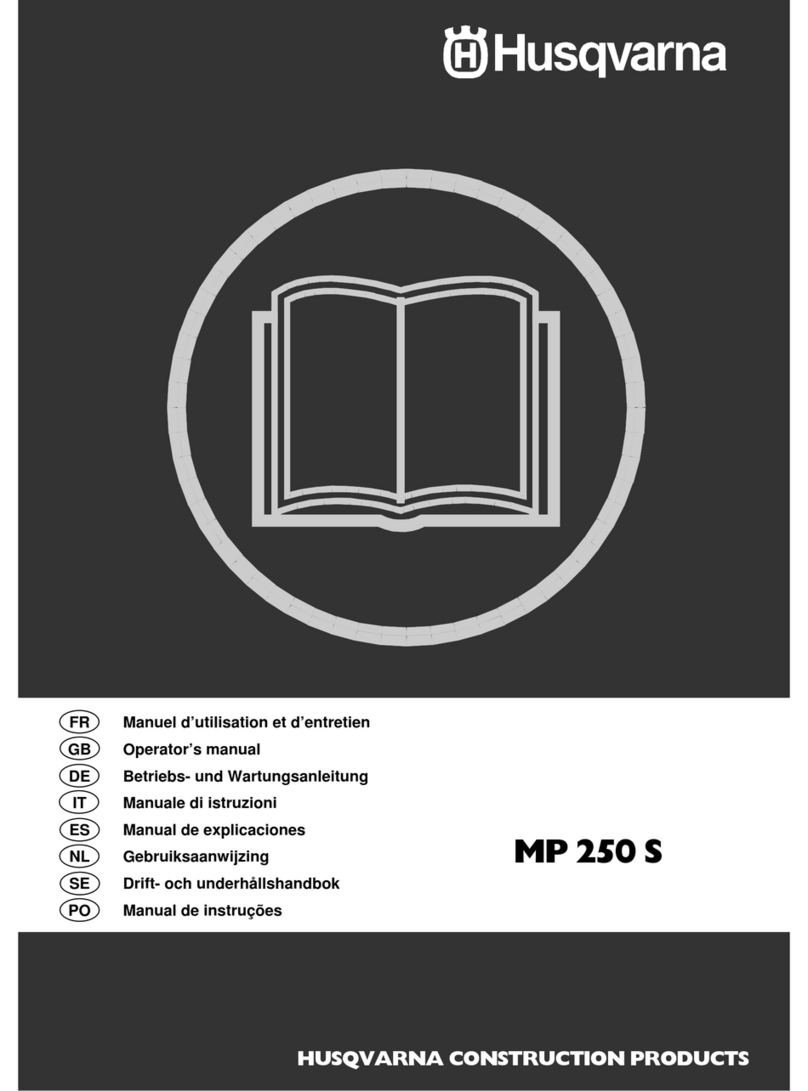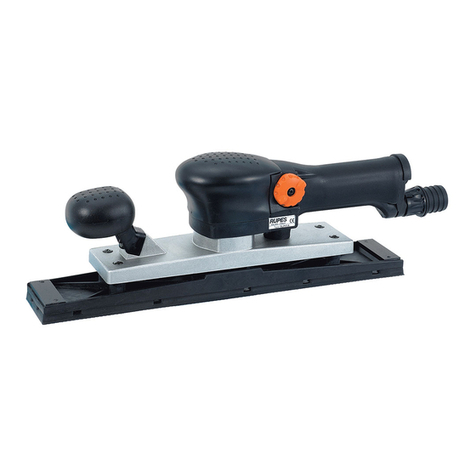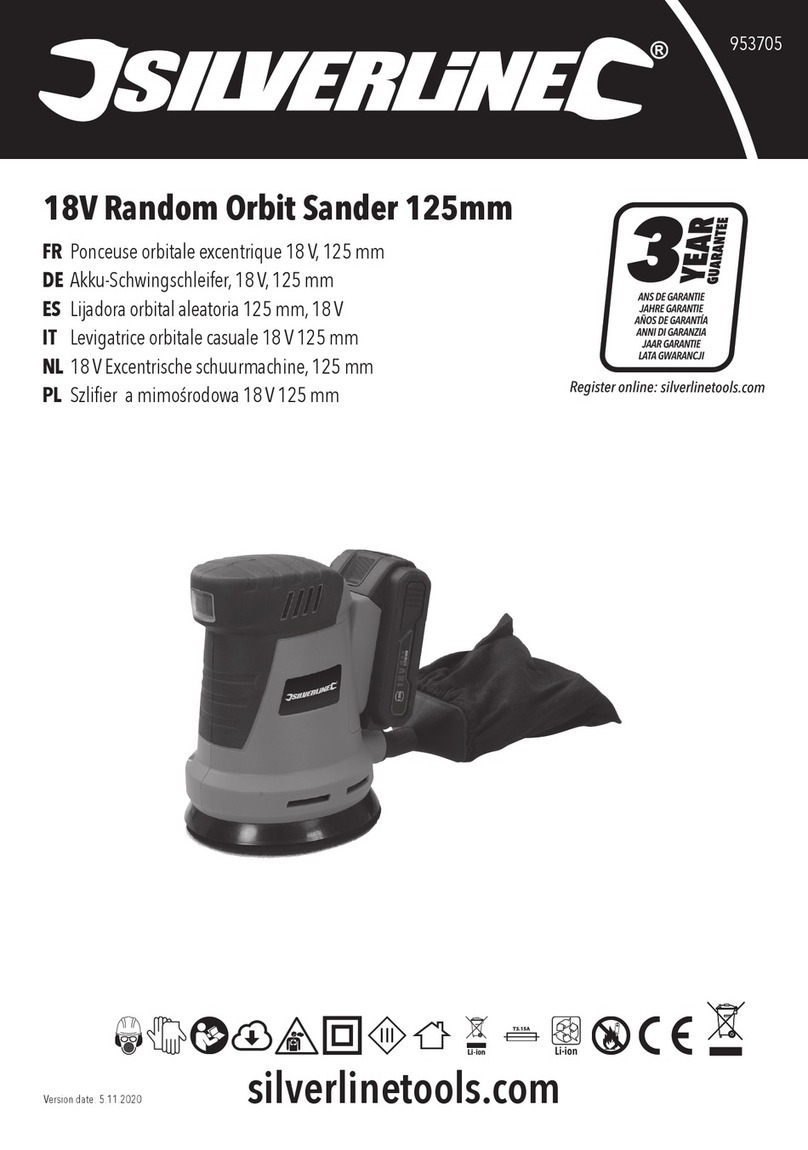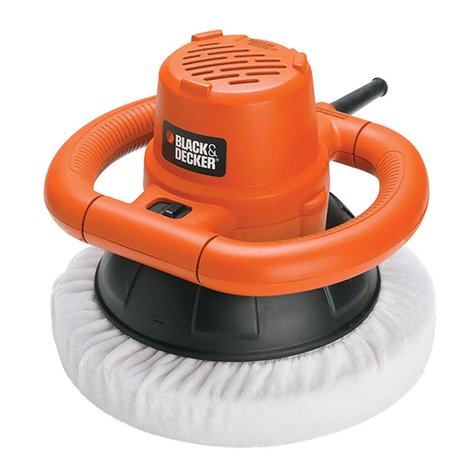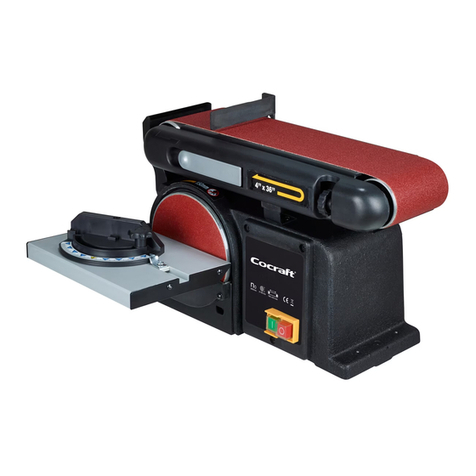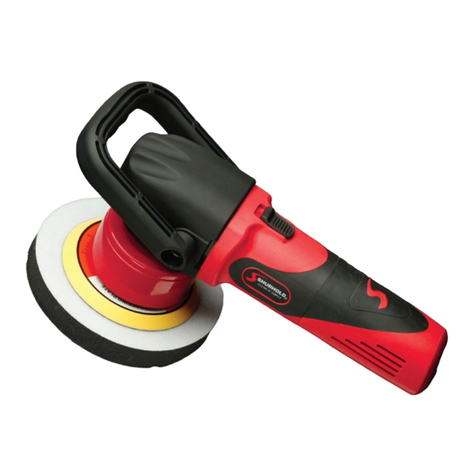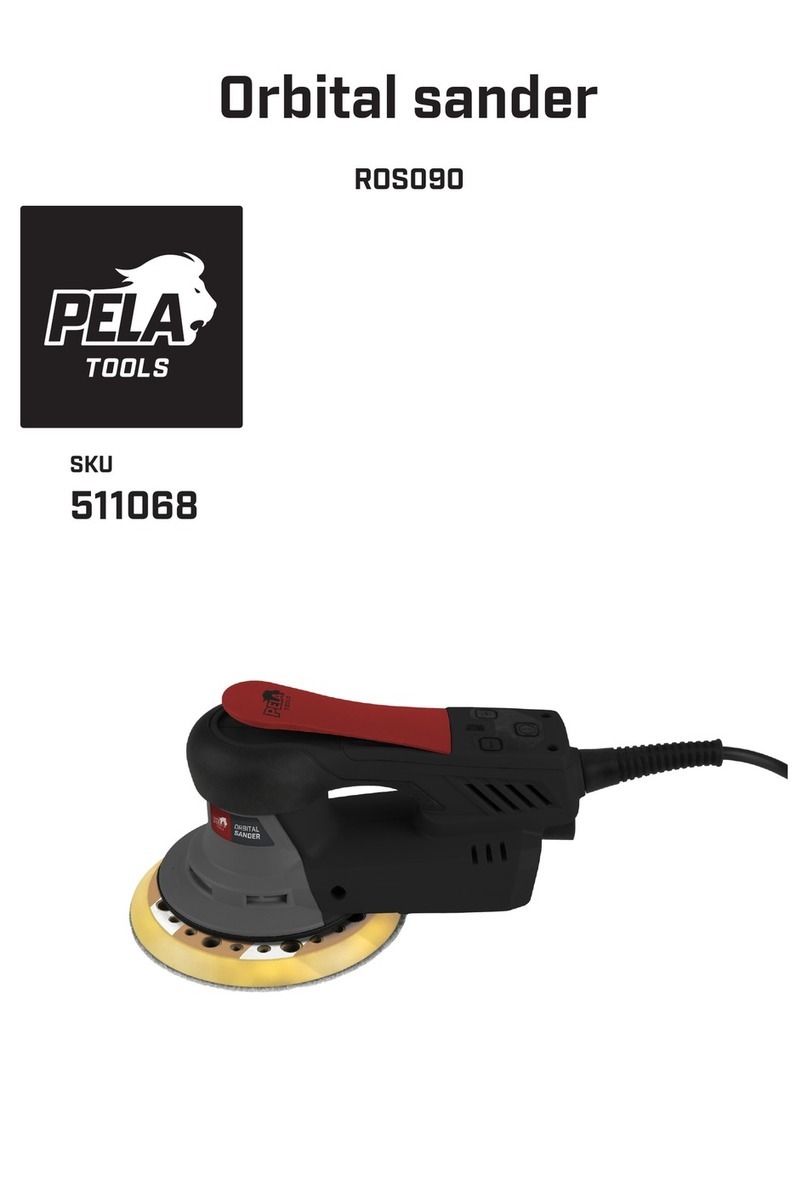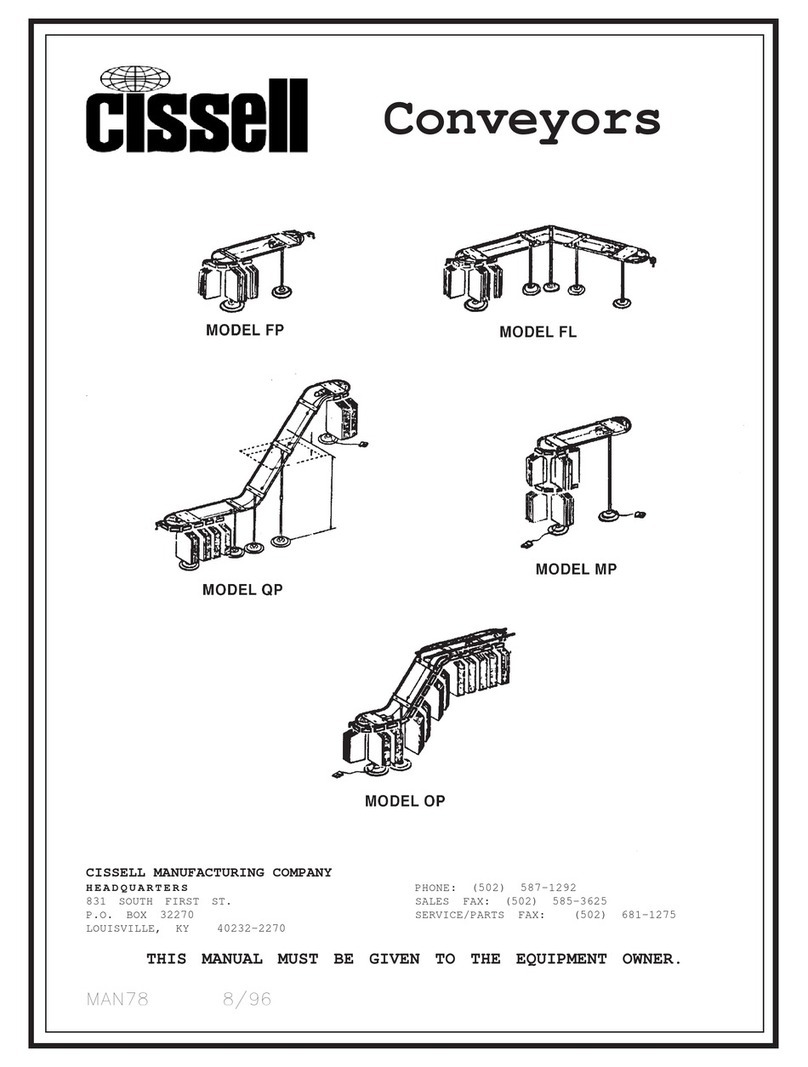Husqvarna Scandinavia 400 User manual

GGBB
DDEE
FFRR
NNLL
PG400
Oper
ator’s manual Bedienungsanweisung
Manuel d’utilisation Gebruiksaanwijzing
Please r
ead the operator’s manual carefully and make sure you understand the instructions before using the machine.
Lesen Sie die Bedienungsanweisung sorgfältig durch und machen Sie sich mit dem Inhalt vertraut, bevor Sie das Gerät
benutzen.
Lire attentivement et bien assimiler le manuel d’utilisation avant d’utiliser la machine.
Neem de gebruiksaanwijzing grondig door en gebruik de machine niet voor u alles duidelijk heeft begrepen.

KEY
T
O SYMBOLS
2
–
English
Symbols on the mac
hine:
W
ARNING! The machine can be a
dangerous tool if used incorrectly or
carelessly, which can cause serious or
fatal injury to the operator or others.
Please read the operator’s manual
carefully and make sure you understand
the instructions before using the
machine.
Wear personal protective equipment.
See instructions under the ”Personal
protective equipment” heading.
WARNING! Dust forms when grinding,
which can cause injuries if inhaled. Use
an approved breathing mask. Always
provide for good ventilation.
This product is in accordance with
applicable EC directives.
En
vironmental marking.
Symbols
on the product or its packaging indicate
that this product cannot be handled as
domestic waste.
By ensuring that this product is taken
care of correctly, you can help to
counteract the potential negative
impact on the environment and people
that can otherwise result through the
incorrect waste management of this product.
For more detailed information about recycling this
product, contact your municipality, your domestic waste
service or the shop from where you purchased the
product.
Other symbols/decals on the mac
hine refer to special
certification requirements for certain markets.
Explanation of warning le
vels
The w
arnings are graded in three levels.
W
ARNING!
CAUTION!
NOTICE!
!
W
ARNING! Indicates a hazardous
situation which, if not avoided, will result
in death or serious injury.
!
CA
UTION! Indicates a hazardous
situation which, if not avoided, could
result in minor or moderate injury.
NO
TICE! Is used to address practices not related to
personal injury.

CONTENTS
English
–
3
Contents
KEY
TO SYMBOLS
Symbols on the machine:
..................................... 2
Explanation of warning levels ............................... 2
CONTENTS
Contents
............................................................... 3
PRESENT
ATION
Dear Customer
, .................................................... 4
Design and features ............................................. 4
PG400 .................................................................. 4
WHA
T IS WHAT?
What is what on the g
rinder? ................................ 5
MA
CHINE´S SAFETY EQUIPMENT
Gener
al ................................................................. 6
Stop/run switch ..................................................... 6
Emergency stop ................................................... 6
OPERA
TING
Gener
al safety precautions ................................... 7
Personal safety ..................................................... 8
Various machine modes ....................................... 9
Handlebar adjustment .......................................... 9
Frame height adjustment ...................................... 10
Weight adjustment ................................................ 11
Connect the vacuum cleaner ................................ 11
Grinding guide ...................................................... 11
Determining the hardness of concrete ................. 12
The motor’s direction of rotation ........................... 13
Diamond selection ................................................ 13
Changing the diamonds ....................................... 15
Transport and storage .......................................... 16
ST
ARTING AND STOPPING
Bef
ore starting ...................................................... 18
Starting ................................................................. 18
Stopping ............................................................... 18
MAINTENANCE
F
aults and trouble shooting .................................. 19
Maintenance ......................................................... 19
Service ................................................................. 19
TECHNICAL D
ATA
T
echnical data ...................................................... 20
EC Declaration of Conformity ............................... 21

PRESENT
A
TION
4
–
English
Dear Customer
,
Thank y
ou for choosing a Husqvarna product!
It is our wish that you will be satisfied with your product
and that it will be your companion for a long time. A
purchase of one of our products gives you access to
professional help with repairs and services. If the retailer
who sells your machine is not one of our authorized
dealers, ask him for the address of your nearest service
workshop.
This operator’s manual is a valuable document. Make
sure it is always at hand at the work place. By following its
content (operating, service, maintenance etc.) the life
span and the second-hand value of the machine can be
extended. If you will sell this machine, make sure that the
buyer will get the operator´s manual.
More than 300 y
ears of innovation
Husqv
arna AB is a Swedish company based on a tradition
that dates back to 1689, when the Swedish King Karl XI
ordered the construction of a factory for production of
muskets. At that time, the foundation was already laid for
the engineering skills behind the development of some of
the world's leading products in areas such as hunting
weapons, bicycles, motorcycles, domestic appliances,
sewing machines and outdoor products.
Husqvarna is the global leader in outdoor power products
for forestry, park maintenance and lawn and garden care,
as well as cutting equipment and diamond tools for the
construction and stone industries.
Owner responsibility
It is the o
wner’s/employer’s responsibility that the operator
has sufficient knowledge about how to use the machine
safely. Supervisors and operators must have read and
understood the Operator’s Manual. They must be aware
of:
• The machine’s safety instructions.
• The machine’s range of applications and limitations.
• How the machine is to be used and maintained.
National legislation could regulate the use of this
machine. Find out what legislation is applicable in the
place where you work before you start using the machine.
The man
ufacturer’s reservation
Subsequent to pub
lishing this manual Husqvarna may
issue additional information for safe operation of this
product. It is the owner’s obligation to keep up with the
safest methods of operation.
Husqvarna AB has a policy of continuous product
development and therefore reserves the right to modify
the design and appearance of products without prior
notice.
For customer information and assistance, contact us at
our website: www.husqvarna.com
Design and f
eatures
V
alues such as high performance, reliability, innovative
technology, advanced technical solutions and
environmental considerations distinguish Husqvarna's
products. Safe operation of this product requires the
operator to read this manual carefully. Ask your
Husqvarna dealer if you need more information.
Some of the unique features of your product are
described below.
PG400
The Husqv
arna PG 400 floor surfacing machines are
designed for grinding concrete surfaces with varying
hardness, terazzo and stone tiles. Their applications
range from rough grinding through to finer finishing. The
machine is intended for light commercial use, for example
homes, garages and small commercial spaces.
• The machine is intended for grinding concrete
surfaces with varying hardness.
• PG400 is robust and easy to use
• The machine can be folded and is collapsible for
simpler transport.
• The machine is equipped with a floating cover.
• 1-phase 3-phase
• 400 mm grinding surface

English
–
5
WHA
T IS
WHA
T?
What is what on the grinder?
1
2
15
16
17
3
8
4
21
10
12
18
22
9
11
4567
14
13
19 20
1
Counter
2 Electrical cabinet
3 Handle / handlebar
4 Locking lever for handlebar adjustment
5 Emergency stop
6 Overload lamp
7 Stop/run switch
8 Connection, quick connection for motor cable
9 Handle for central hinge
10 Plug
11 Rubber wheels
12 Connection, vacuum hose
13 Lock function
14 Attachment for motor/grinding head
15 Lifting eye
16 Electric motor
17 Lift handle, motor
18 Floating cover
19 Brush list
20 Tool plate
21 Operator’s manual
22 Counterweights

MA
CHINE´S SAFETY EQ
UIPMENT
6
–
English
General
This section descr
ibes the machine´s safety equipment,
its purpose, and how checks and maintenance should be
carried out to ensure that it operates correctly.
Stop/run s
witch
The star
t/stop knob is used to start and stop the machine.
Chec
king the stop/run switch
Chec
k that the emergency stop or machine stop button
are not pressed by turning them clockwise.
• Reduce the pressure between grinding disc and floor
by lightly pushing down the handle without lifting the
grinding unit from the floor when starting.
• Start the machine by turning the 0/1 knob to position
1 (drive). The machine will then start smoothly and
accelerate to the set speed within 5 seconds.
• Turn the start/stop knob to '0' (stop) to stop the
machine.
Emer
gency stop
The emergency stop is used to quic
kly switch off the
engine. The emergency stop at the machine breaks the
mains power supply.
T
esting the emergency stop
•
Press the emergency stop. Check that the engine
stops.
• Disengage Emergency Stop button (twist clockwise).
!
W
ARNING! Never use a machine with
faulty safety equipment.The machine's
safety equipment must be checked and
maintained as described in this section.
If your machine fails any of these checks
contact your service agent to get it
repaired.
CA
UTION! Connect the motor cable to the electrical box
before connecting the plug.
12
~1 mm
12

OPERA
TING
English
–
7
General saf
ety precautions
•
Do not use the machine without first reading and
understanding the contents of this Operator’s Manual.
Save all warnings and instructions for future
reference.
W
ork area safety
•
Keep work area clean and well lit.
Cluttered or dark
areas invite accidents.
• The machine should not be used in areas where
potential for fire or explosions exist.
Electrical saf
ety
•
Check that the mains voltage corresponds with that
stated on the rating plate on the machine.
• Inspection and/or maintenance should be carried out
with the motor switched off and the plug disconnected.
• Always shut down the machine before disconnecting
the power plug.
• Never drag the machine by means of the cord and
never pull out the plug by pulling the cord. Hold the
plug to disconnect the power cord.
• Never use the machine if any cable or plug is
damaged, but hand it in to an authorized service
workshop for repair.
• The machine must never be driven to such a depth in
water that it reaches up to the machine’s equipment.
The equipment can be damaged and the machine can
be live, resulting in personal injuries.
• Always have the power cable disconnected when
connecting and disconnecting the contact between
the motor and the electrical box.
Gr
ounding instructions
•
The machine is equipped with a grounded cord and
plug and should always be connected to a grounded
outlet. This reduces the risk of electric shock in the
event of malfunction.
• The use of adaptors is not allowed with the machine.
Extension cor
ds and cables
•
The marking on the extension cable must be the same
or higher than the value stated on the machine’s rating
plate.
• Use grounded extension cables.
•
When operating a power tool outdoors, use an
extension cord suitable for outdoor use.
Use of a
cord suitable for outdoor use reduces the risk of
electric shock.
• Keep the connection to the extension cord dry and off
the ground.
• Keep cable away from heat, oil, sharp edges or
moving parts. Damaged or entangled cable increase
the risk of electric shock.
• Check that the cables are intact and in good condition.
Never use the machine if any cable is damaged, but
hand it in to an authorized service workshop for repair.
• To avoid overheating do not use the extension cord
while it is rolled up.
• Ensure the cord is behind you when you start to use
the machine so that the cord will not be damaged.
• When using an extension cable, use only certified
extension cables with sufficient reach.
!
W
ARNING! This section describes basic
safety directions for using the machine.
This information is never a substitute for
professional skills and experience. If you
get into a situation where you feel unsafe,
stop and seek expert advice. Contact your
dealer, service agent or an experienced
user. Do not attempt any task that you feel
unsure of!
!
W
ARNING!There is always a risk of shocks
from electrically powered machines. Avoid
unfavourable weather conditions and body
contact with lightning conductors and
metal objects. Always follow the
instructions in the Operator’s manual to
avoid damage.
Never connect the machine to a outlet if
plug or cord is damaged.
!
CAUTION! The equipment fulfills the
requirements in EN61000-3-11 and is
subject for conditional connection to the
mains. It may be connected in consultation
with the supply authority.
The equipment will only be connected to
the mains supply with impedance lower
than 0,39 ohm, applies only to 3-phase.The
system impedance at the interface point
may be obtained from the supply authority.
If the mains supply has higher system
impedance, short voltage dips may appear
when the equipment is started. This may
influence the operation of other products,
e.g flickering lights.
!
WARNING! Improper connection can
result in the risk of electric shock.
Contact a qualified electrician if in doubt
as to whether the appliance is properly
grounded.
Do not modify the plug. If it will not fit the
outlet have a proper outlet installed by a
qualified electrician. Make sure local
regulations and ordinances are followed.
If the grounding instructions are not fully
understood contact a qualified
electrician.

OPERATING
8 – English
Personal safety
•Wear personal protective equipment.See instructions
under the ”Personal protective equipment” heading.
• Never use the machine if you are tired, if you have
drunk alcohol, or if you are taking medication that
could affect your vision, your judgement or your co-
ordination.
• Never allow anyone else to use the machine without
first ensuring that they have read and understood the
contents of the operator’s manual.
• All operators shall be trained in the use of the
machine. The owner is responsible for ensuring that
the operators receive training.
• People and animals can distract you causing you to
lose control of the machine. For this reason, always
remain concentrated and focused on the task. Never
allow children to use or be in the vicinity of the
machine.
• Be careful as clothing, long hair, and jewellery can get
caught in moving parts.
• There is always a risk of crush injuries when working
with products containing moving parts. Keep your
distance!
• Never leave the machine unsupervised with the motor
running.
• Make sure that there is always another person close
at hand when you use the machines, so that you can
call for help if an accident should occur.
• Always ensure you have a safe and stable working
position.
Personal protective equipment
•
Hearing protection
• Protective goggles or a visor
• Breathing mask
• Heavy-duty, firm grip gloves.
• Tight-fitting, heavy-duty and comfortable clothing that
permits full freedom of movement.
• Boots with steel toe-caps and non-slip sole.
•
Always have a first aid kit nearby.
Use and care
•Only use the machine for the purpose it was intended
for.
• Keep all parts in good working order and ensure that
all fixtures are properly tightened.
• Never use a machine that is faulty. Carry out the safety
checks, maintenance and service instructions
described in this manual. Some maintenance and
service measures must be carried out by trained and
qualified specialists. See instructions under the
Maintenance heading.
• Do not modify safety equipment. Check regularly that
they function as they should. The machine must not
be run with defective or disassembled safety
equipment.
• Never use a machine that has been modified in any
way from its original specification.
• Always use genuine accessories. Contact your dealer
for more information.
• Machinery should only be started when grinding
heads are resting on the ground unless carrying out a
testing procedure as outlined in this manual.
• The machine should not be started without the brush
list attached. It is essential a good seal between
machine and floor be established for safety, especially
when operating in dry grinding applications.
• During grinding, the machine must be connected to a
vacuum cleaner for the removal of the dust.
• Make sure the machine is without power when
changing diamond tools by pressing in the emergency
stop and disconnecting from the power outlet.
• Always dismantle the diamond tool after each grinding
operation.
• Make sure that the brush list is intact and clean and
that it seals tightly against the floor. Damaged brush
list should always be replaced.
• The tool plate continues to rotate for a while after the
motor has been switched off. Maintain grinding action
until the fan has come to a complete stop. Ensure the
tool plate has stopped rotating before lifting up the
machine.
• When grinding adhesive, asphalt, paint or the like, lift
the front of the machine slightly after use to prevent it
sticking to the floor from the heat. Ensure the tool
plate has stopped rotating before lifting up the
machine.
• Diamond tools may be very hot after use. Leave
machine to cool off before removing the diamond
segments. Use protective gloves.
• Always use the machine mounted lifting eye when
lifting.
• Always carry the machine by the carrying handle and
the handle.
!
WARNING! Overexposure to vibration
can lead to circulatory damage or nerve
damage in people who have impaired
circulation. Contact your doctor if you
experience symptoms of overexposure
to vibration. Such symptoms include
numbness, loss of feeling, tingling,
pricking, pain, loss of strength, changes
in skin colour or condition.These
symptoms normally appear in the
fingers, hands or wrists.These
symptoms may be increased in cold
temperatures.
!
WARNING! You must use approved
personal protective equipment whenever
you use the machine. Personal protective
equipment cannot eliminate the risk of
injury but it will reduce the degree of
injury if an accident does happen. Ask
your dealer for help in choosing the right
equipment.

OPERATING
English – 9
Various machine modes
Operating position
Service position
Tilting transportation position
Lifting transportation position
• Standing beside the wheel chassis, squeeze the
handle on the central hinge while simultaneously
angling the upper frame forward to the lifting position.
Lifting eye
• Always use the machine mounted lifting eye when
lifting. To ensure a balanced lift, use a spotter as
support when lifting.
Handlebar adjustment
The handle can be infinitely adjusted. The handle lock
knobs are operated clockwise, counterclockwise or
placed in idle postion.
• Loosen the lock knobs and adjust the handle to
desired position.
• Fix the position by tightening the lock knobs.
• When not in use, pull the handle lock knobs upwards
and place them into idle position.
2
1

OPERATING
10 – English
Frame height adjustment
The angle of the frame can be adjusted to alter the weight
distribution of the chassis to decrease or increase
grinding pressure. It can also be used to allow a more
comfortable working position for different operators.
• Disconnect the motor cable from the electrical box.
• Standing beside the grinder, squeeze the handle on
the central hinge while simultaneously angling the
upper frame to the inclined transport position.
• Loosen the nuts a few turns to release any pressure.
• Pull out the locking pins and remove the bolts on each
side of the grinding head.
• Remove the wheel chassis from the grinding head.
• Standing beside the wheel chassis, squeeze the
handle on the central hinge while simultaneously
angling the upper frame forward to the lifting position.
• Loosen the locking knobs on the support foot.
• Hold the handlebar to stabilize the frame and lift out
and up the support foot.
• Choose the appropriate position required by
tightening up the locking knobs in the correct hole.
The lower hole for a higher handlebar and greater
grinding pressure. The upper hole for a lower handlebar
and less grinding pressure.
1
32

OPERATING
English – 11
Handle heights
Weight adjustment
The grinding pressure can be adjusted for different
applications by adding or removing weight off the back of
the electrical box. Below matrix shows grinding pressure
for each height and counterweight setting.
Grinding pressures (4kW 3-phase)
Grinding pressures (4kW 1-phase)
In order to change grinding pressure, plates can be added
or removed.
• Squeeze the handle on the central hinge and angle
the upper frame forward to its horizontal lifting
position.
• Loosen the 4 screws that holds the weight plates and
remove 1 or 2 plates to achieve the desired pressure.
Connect the vacuum cleaner
Use a Husqvarna dust extraction system for complete
dust control.
• Connect the dust extractor to the machine. Use a 50
mm (2 inch) hose.
Make sure that the filters in the vacuum cleaner are intact
and clean. Pay attention to dust during operation.
Grinding guide Diamonds
Background
The diamond segment comprises usually of two
components:
• Diamonds (also called diamond crystals or corn).
Changing the size of the diamonds or corn will change
the coarseness or fineness of the scratches after the
grinding process.
• A bonding agent (metal or plastic). Powder is mixed
and suspended in a metal or plastic bonding agent. If
metal is used as a bonding agent, the finished product
is called metal-bonded or sintered diamond segment.
If plastic is used as a bonding agent, the finished
product is called plastic-bonded diamonds or
polishing disc. By changing the hardness of the
bonding agent, you can change how quickly or slowly
the diamond abrasive is worn down.
General Principles
General rules for using diamond tools when grinding
follow below. As with all rules, there are exceptions or
occasions when they do not apply.
Diamond grit size
Changing the size of the diamond grit to a smaller
particle/grit size will effect the performance of the
diamond tool in the following ways:
• Create a finer scratch pattern.
• Increased service life of diamond tools.
The opposite will occur when changing to a larger
particle/grit size.
Hole position Handle height, mm/inch
Upper 835/33
Center 925/36
Lower 1000/39
Counter
weights
Handle
position
Low, kg/lbs
Handle
position
Center, kg/lbs
Handle
position
High, kg/lbs
1 49/108 51/112 53/117
2 43/95 46/101 49/108
3 38/84 41/90 45/99
Counter
weights
Handle
position
Low, kg/lbs
Handle
position
Center, kg/lbs
Handle
position
High, kg/lbs
1 50/110 52/115 54/119
2 44/97 47/104 49/108
3 39/86 43/95 46/101

OPERATING
12 – English
Binding agent
Increasing hardness of bond will:
• Create a finer scratch pattern.
• Increased service life of diamond tools.
• Decrease production rate.
The opposite will occur when making the metal or resin
bond softer.
Number of diamond tools under the machine
An increased number of tools under the machine leads to:
• Reduce pressure on each individual diamond
segment - reduce wear rate on diamond segments.
• Reduce load on the machine and cause the grinder to
draw less current.
• Create a smoother scratch pattern (particularly on soft
floors).
The reverse happens if you reduce the number of tools
under the machine.
Summary of diamond principles
The diamond tools must be worn in order to give a high
grinding efficiency. The wear on diamond tools can be
affected by the following factors:
• Pressure.
• Hardness of bond.
• Diamond grit size.
• Number of segments under the machine.
• Adding an additional abrasive (e.g. sand, silicone
carbide) on the floor will increase wear.
Generally, the faster a diamond segment wears, the faster
the productivity will be. By varying the above factors,
changes can also be made to effect the following:
• Scratch pattern.
• Current draw of machine.
• Flatness of floor (see next section).
• Ease of operation.
Determining the hardness of
concrete
All concretes are measured by their compressive strength
and depending on which part of the world you are from,
different compressive strength indices (e.g. PSi & MPa)
are used. Generally, the higher the compressive strength
rating, the harder the concrete and therefore, the harder it
will be to grind.
But there are also factors other than compression
strength that determine how hard a floor is and which
therefore affect the choice of diamond tool. As it is most
often only the top layer (5 mm) that we are talking about
from a grinding point of view, the surface treatment of the
concrete and the condition of the concrete surface have
many times a greater impact on the choice of diamond
segment than the compression strength.
Surface factors to consider when making a diamond
selection
Generally, if a concrete surface is very smooth (i.e. Most
likely it has been heavily trowelled/helicoptered), the
concrete will behave as if it has a high compressive
strength and therefore, require a soft bond segment.
Accordingly, if a concrete surface is coarse/aggressive
(e.g. rain-damaged, shot blasted, scarified, exposed
aggregate e.t.c.), the concrete will behave as if it has a
low compressive strength and therefore, require a hard
bond segment.
Surface coatings/contaminants (e.g. Epoxy coatings,
ceramic tile adhesives, levelling compounds/screeds) will
often have a larger bearing on what diamond to select,
than will the compressive strength of the concrete.
As a general rule, when grinding a concrete slab for the
first time and you are unsure about its hardness, always
begin with harder bond diamonds under the machine.
This will ensure the least amount of wear on the diamond
segments. If a hard diamond segment is not suited to the
application, all it has cost is a little amount of time without
wearing out the diamonds.
If performed the other way around (i.e. a soft segment is
used to begin with) and the concrete is soft or possesses
an abrasive surface or surface contaminant, it is quite
possible to wear-out a considerable amount of diamond in
very short period of time.

OPERATING
English – 13
The motor’s direction of rotation
3-phase
The motor´s direction can be changed by reversing the
poles in the power plug.
1-phase
The arrow shows the direction of rotation of the motor.
Diamond selection
They way diamond segments are set-up on the grinding
unit will greatly influence the performance of the machine,
the productivity levels and also the finished floor quality.
There are a number of different diamond configurations
that can be achieved on the PG 400.
Metal bond diamonds
Full set - inner and outer row
• Even smooth grinding, less aggressive.
Full set - outer row
• Aggressive concentrated removal.
Half set - inner and outer row
• Aggressive smooth removal.
Half set - outer row
• Very aggressive concentrated removal.
Note: Using only 3 tools will cause a greater amperage
draw.
NOTICE! The Piranha/PCD tools are designed to run in
only one direction.
NOTICE! Husqvarna’s recommendation is to use
double segments under the PG 400.

14 – English
OPERATING
Select the correct metal bond diamonds for your application
The following suggestion cover the basic configurations for metal bonded diamond tools.
Applications Metal bond Grit size Full set - inner
and outer row
Full set -
outer row
Half set - inner
and outer row
Half set -
outer row
Flatten floor - Hard concrete Soft 16 or 30 X
Flatten floor - Medium concrete Medium 16 or 30 X
Flatten floor - Soft concrete Hard 16 or 30 X
Ceramic tile adhesive removal Medium PIRANHA™
or 16-30 X
Vinyl or Carpet glue removal - Hard
concrete Soft PIRANHA™
or 16-30 X X
Vinyl or Carpet glue removal -
Medium concrete Medium PIRANHA™
or 16-30 X X
Vinyl or Carpet glue removal - Soft
concrete Hard PIRANHA™
or 16-30 X X
Epoxy paint removal - Hard concrete Soft PIRANHA™
or 16-30 X X
Epoxy paint removal - Medium
concrete Medium PIRANHA™
or 16-30 X
Epoxy paint removal - Soft concrete Hard PIRANHA™
or 16-30 X
Rain damaged concrete Hard 16-30 X X
Smoothen exposed aggregate Hard 16-30 X X
Lippage removal in terrazzo/stone
tiles Soft 30 or 60 X
Surface polishing of concrete floors -
Hard concrete Soft 60 X X
Surface polishing of concrete floors -
Medium concrete Medium 60 X X
Surface polishing of concrete floors -
Soft concrete Hard 60 X X
Grinding to exposed aggregate in
concrete - Hard concrete Soft 16-30 X X X
Grinding to exposed aggregate in
concrete - Medium concrete Medium 16-30 X X X
Grinding to exposed aggregate in
concrete - Soft concrete Hard 16-30 X X
Flatten undulation in concrete floors
- Hard concrete Soft 16 or 30 X X X
Flatten undulation in concrete floors
- Medium concrete Medium 16 or 30 X X
Flatten undulation in concrete floors
- Soft concrete Hard 16 or 30 X X

OPERATING
English – 15
Resin bond diamonds
Redi Lock resin attachment adaptor
Full set - outer row
Half set - outer row
Selecting the correct resin bond diamond
configuration for your application
Changing the diamonds
Shut down the machine and disconnect the power plug.
Have a set of gloves ready, as diamond tools can get very
hot.
• Put the machine into service position.
• Pull back on handle to lift grinding head off the ground.
• Lay machine back on the ground.
• Put on gloves.
• Use a hammer to remove the diamond segments.
• Affix new diamond segments on the grinding disc.
• Once new diamond segments have been attached,
reverse procedure to lower machine to ground.
Applications Full set -
outer row
Half set -
outer row
Polishing terrazzo/stone tiles X
Resurfacing terrazzo/stone
tiles X
Surface polishing of concrete
floors - Hard concrete X
Surface polishing of concrete
floors - Medium concrete X
Surface polishing of concrete
floors - Soft concrete X
!
WARNING! CP1200 and P1100 must not
under any circumstances be used with
a Redi lock adapter.

OPERATING
16 – English
Transport and storage
• Secure the equipment during transportation in order
to avoid transport damage and accidents.
The machine should be transported under cover where
possible, limiting the exposed to natural elements - in
particular rain and snow.
• Store the equipment in a lockable area so that it is out
of reach of children and unauthorized persons.
• The machine should always be stored in a dry place
when not in use.
Transport
The machine can be taken apart in to two components to
give a smaller size when transporting.
• Disconnect the motor cable from the electrical box.
Standing beside the grinder, squeeze the handle on the
central hinge while simultaneously angling the upper
frame to the inclined transport position.
• Loosen the nuts a few turns to release any pressure.
• Pull out the locking pins and remove the bolts on each
side of the grinding head.
• Remove the wheel chassis from the grinding head.
• Standing beside the wheel chassis, squeeze the
handle on the central hinge while simultaneously
angling the upper frame forward to the lifting position.
• Loosen the locking knobs on the support foot.
• Hold the handlebar to stabilize the frame and lift out
and up the support foot.
1
32

OPERATING
English – 17
•Holding the handlebar with one hand, again squeeze
the handle for the central hinge while lowering the
upper frame into the folded position.
• Secure the machine with locking pin and bolt.
Lifting eye
• Always use the machine mounted lifting eye when
lifting.
Secure the machine
• The machine is equipped with holes for strapping
down the machine to the vehicle during transport.
Attach the strapping hook into the hole in the chassis
and tighten it firmly downwards.
4X

STARTING AND STOPPING
18 – English
Before starting
• Perform daily maintenance.
• Position grinder on the working area.
• Make sure there are diamonds beneath the machine
and that they are firmly attached.
• Connect the dust extractor to the machine.
• Use locking knobs for handlebar adjustment to set
most comfortable working height.
• Make sure the motor cable is connected to the
electrical box before the machine is plugged into an
electric socket.
• Plug the machine into an electric socket.
• Check that the emergency stop button is not pressed
by turning it clockwise.
• Check the motor’s direction of rotation
Starting
•Reduce the pressure between grinding disc and floor
by lightly pushing down the handle without lifting the
grinding unit from the floor when starting.
• To start the machine. Start the machine by turning the
0/1 knob to position 1 (drive). The machine will then
start smoothly and accelerate to the set speed within
5 seconds.
Stopping
•Turn off the machine with the start/stop knob, turn it to
'0' (stop).
• Keep grinding segments in contact with the floor when
stopping. This will help bring the machine to a
complete stop quickly. Do not lift the grinding head off
the floor when stopping as this can create a significant
amount of dust in the air and damage the floor.
• Pull out the plug.
!
WARNING! Please read the operator’s
manual carefully and make sure you
understand the instructions before using
the machine.
Wear personal protective equipment. See
instructions under the ”Personal
protective equipment” heading.
Make sure no unauthorised persons are
in the working area, otherwise there is a
risk of serious personal injury.
Check that the machine is assembled
correctly and do not show any signs of
damage.
12
~1 mm

MAINTENANCE
English – 19
Faults and trouble shooting
The machine does not start
• Check the power supply and the power cables to
make sure they are not damaged.
• Check that the emergency stop button is not pressed
by turning it clockwise.
• Check the overload lamp. If the overload lamp is on,
allow the motor to cool down for a few minutes until the
machine is automatically reset.
Machine is hard to hold onto
• Too few diamonds under the machine or the wrong
type of tool for the application (stiff adhesive or soft
floor coverings result in high stress to the machine
and the user if there are too few diamonds under the
machine). Usually also accompanied by high current
draw by motor.
Use the number of diamonds recommended by
Husqvarna to reduce the stress on the grinder and the
user.
Machine is jumping around
•Diamonds may not be fitted correctly or have different
heights. Check to ensure all diamonds are fitted
correctly and are the same height.
The machine stops after just a while
• The machine is overloaded and the overload
protection has been released. Reduce load by adding
more diamond under the grinder or moving to a harder
bond. Load adjustments can also be done by
changing weight and height setting. The machine will
reboot after about a minute when the motor has
cooled off.
• Ensure any extension cables are not under
dimensioned.
The machine stops during start-up
• The electric motor has overloaded and the overload
lamp is on. Give the machine one or two minutes to
reset and try again. When this does not help, contact
an authorised service workshop.
• Ensure any extension cables are not under
dimensioned.
Maintenance
Used correctly, the machine is an extremely low-
maintenance and reliable product.
Daily maintenance
• Cleaning
• Electrical Feed
• Brush list
Cleaning
Always pull out the plug from the outlet socket before
cleaning, maintenance or assembly.
Always clean all the equipment at the end of the working
day. Do not use a high pressure washer to clean the
machine.
In order for the machine to always be cooled sufficiently
the cooling air openings must be kept clear and clean.
Electrical Feed
Check that the cord and extension cord are intact and in
good condition.
Never use the machine if the cord is damaged, hand it in
to an authorized service workshop for repair.
Brush list
Make sure the brush strip is whole and reaches down to
the floor.
Service
NOTICE! Good motor performance depends on proper
voltage. Extension cables that are too long and/or which
have a gage that is too small, reduce power to the motor
under load.
IMPORTANT! Inspection and/or maintenance should be
carried out with the motor switched off and the plug
disconnected.
!
WARNING! Never use damaged cables.
They can cause serious, even fatal,
personal injuries.
IMPORTANT! All types of repairs may only be carried
out by authorised repairmen. This is so that the
operators are not exposed to great risks.

20 – English
TECHNICAL DATA
Technical data
Noise emissions
Note 1: Noise emission in the environment measured as sound power according to EN 60335-2-72. Expected
measurement uncertainty 2,5 dB(A).
Note 2: Sound pressure level according to EN 60335-2-72. Expected measurement uncertainty 4 dB(A).
Note 3: Vibration level according to EN 60335-2-72. Reported data for vibration level has a typical statistical dispersion
(standard deviation) of 1 m/s2
PG400 (3-phase,
200-240V)
PG400 (3-phase,
400-480V)
PG400 (Single-
phase, 220-240V)
50 Hz 60 Hz 50 Hz 60 Hz 60 Hz
Motor Power, kW/hp 4,0/5,4 4,8/6,5 4,0/5,4 4,8/6,5 3,0/4,0
Rated current, A 15 15 9 9 18
Rated voltage, V 220-240 220-240 400-480 400-480 220-240
Weight, kg/lbs 116/256 116/256 110/243 113/249 119/262
Grinding width, mm/inch 400/16 400/16 400/16 400/16 400/16
Grinding pressure, kg/lbs 34-42/
75-93
34-42/
75-93
43-49/
95-108
38-45/
84-99 39-46/86-101
Rotation speed - grinding disc, rpm 1445 1740 1445 1740 1140
Noise emissions (see note 1)
Sound power level, measured dB(A) 98
Sound levels (see note 2)
Sound pressure level at the operators ear, dB(A) 84,7
Vibration levels (see note 3)
Handle right, m/s26,5
Handle left, m/s25,2
Other manuals for Scandinavia 400
2
Table of contents
Languages:
Other Husqvarna Sander manuals
Popular Sander manuals by other brands
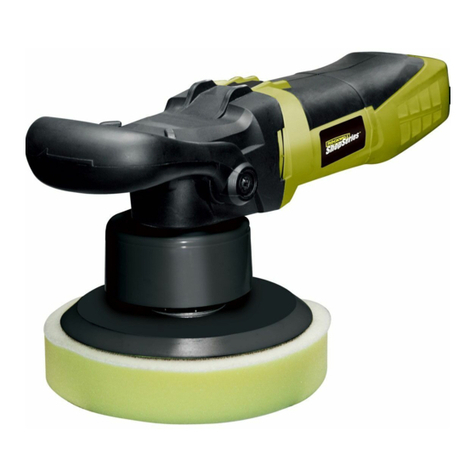
Rockwell
Rockwell ShopSeries RS4503 manual
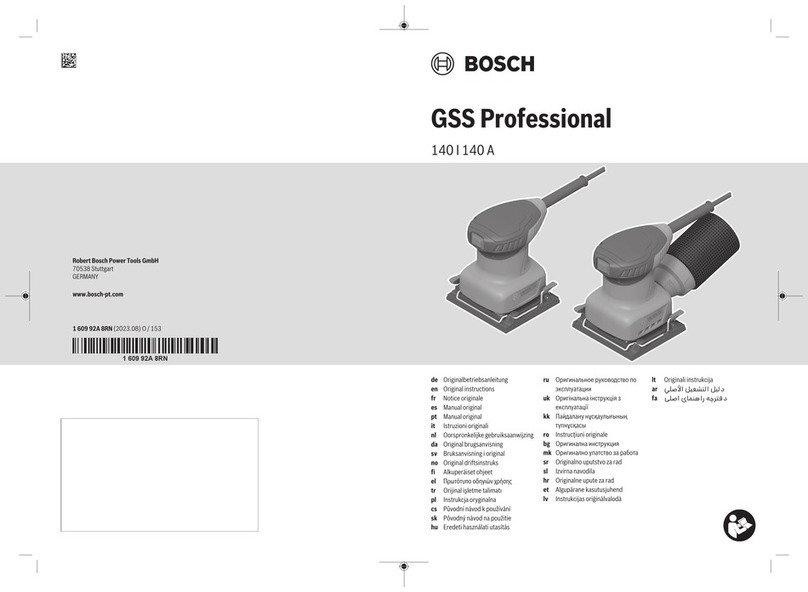
Bosch
Bosch Professional GSS 140 Original instructions

Triton
Triton TR209051 Operating and safety instructions

Diprofil
Diprofil FPK/R Operation guide

Milwaukee
Milwaukee 6130-33 Operator's manual
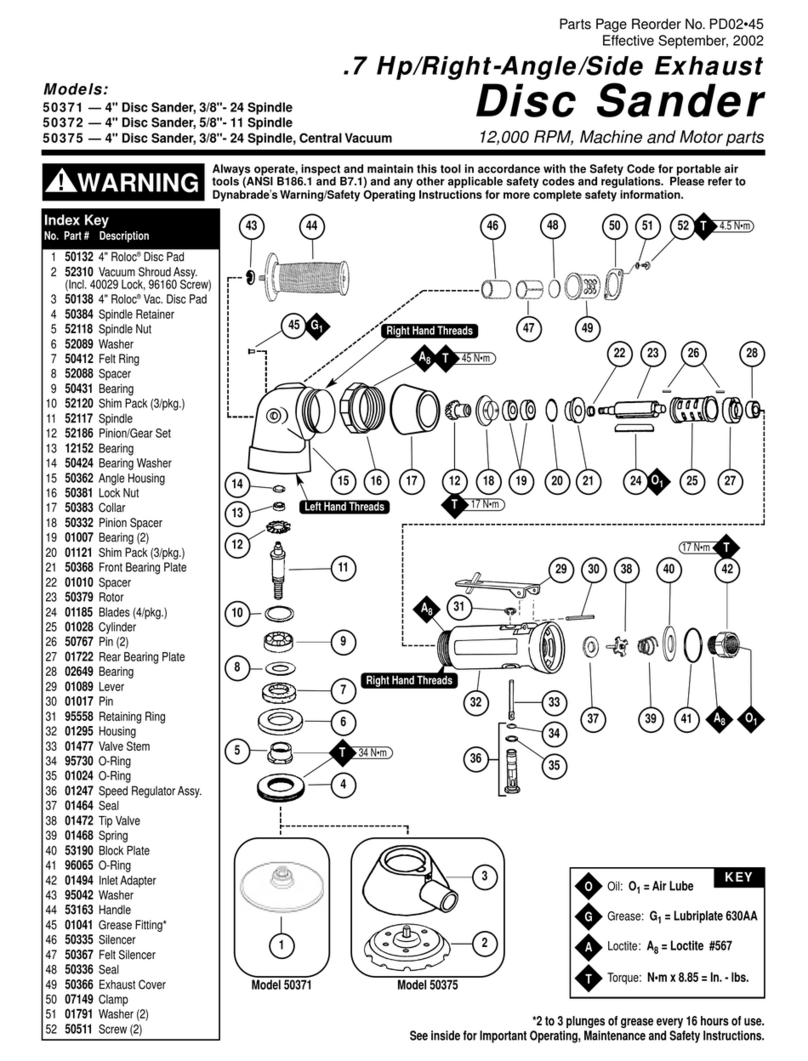
Dynabrade
Dynabrade 50371 Important operating, maintenance and safety instructions
